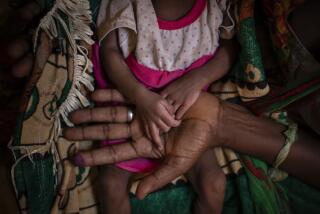Dutch Now Question Effectiveness of Giving Aid to the Third World : Netherlands: A survey shows that a third of all development projects end in failure.
THE HAGUE — The Netherlands, long proud of being among the most generous donors to the Third World, is worried that the aid it gives is doing little good.
Newspapers have given wide coverage to a Dutch-built airport hanger in Tanzania that remains unused, a farming project in Zambia that collapsed as soon as farmers needed spare parts for their new tractors and Dutch dairy cows, exported to Sri Lanka, dying in the heat.
“I do not think we have a specific problem, compared with other European countries,” former Development Cooperation Minister Piet Bukman said in an interview.
“The issue of the quality of development aid is on the table all over the world,” said Bukman, who ended three years in the post when a new Dutch government came to power Nov. 7.
The Dutch, who have a traditionally international outlook, take development cooperation more seriously than most.
The Netherlands earmarks 1.5% of its gross national product each year for aid to developing nations, making it among the world’s most generous donors.
The $2.6 billion the Dutch will give away this year is far more proportionally than the United States, which gives away about 0.2% of its GNP, Britain (0.3%), West Germany (0.5%) or France (0.8%), according to World Bank figures.
A recent study said an overwhelming majority of the Dutch support their government’s generous policies, but found that 80% believed the help was “too Western” and that aid organizations were often at cross-purposes with each other.
Critics say Dutch aid is increasingly linked to the sale of Dutch goods--useful or not--and allege that many development projects display just plain ignorance.
An internal Development Ministry review shows that two-thirds of Dutch import subsidies in 1988 went to underwrite the purchase of Dutch-made goods.
Bukman defends the policy he did much to promote after becoming minister in 1986.
“If an industrialized country has a good package to offer, there is nothing wrong with combining the interest of the developing country and the interest of the developed country,” he said.
Other experts, however, say the results mean countries end up with sophisticated medical equipment they lack the expertise to use, fertilizer that is useless for their crops and food imports they could have bought more cheaply elsewhere.
“Some Dutch companies make big profits off these projects and the developing countries end up not always getting value for the aid money,” said Paul Hoebink of Nijmegen University’s Third World Center.
The criticism has been strengthened by another ministerial study that made headlines when it showed that a third of all Dutch aid projects failed.
Only one-third were considered successful, and the remaining third partly accomplished their goals, the study concluded.
The problems are often cultural.
A project to provide running water in a village in India to make life easier for women instead angered them. By doing away with the need to visit the local well, the project deprived women of their main chance to venture outdoors and socialize.
A plan to train young men in Ghana in new grain-raising methods failed dismally. Once back home, the young men had no power to put the new methods into effect because in their tradition-bound society, only the old have the clout to introduce change.
Bukman, however, defends the Dutch record.
“Money is spent on developing countries in very difficult circumstances, under poor economic conditions. . . . People forget that in our society, too, we have many examples of mismanagement and bad decisions,” he said.
In an effort to avoid cultural problems, the Dutch are trying to use more local experts in development projects--a practice that also cuts down on costs.
The Netherlands has moved away from straight food aid to helping create permanent structures to strengthen the economy of poor countries, for example, by building ports and dredging waterways.
“In the 1960s and ‘70s there was a tendency to say what we must do is alleviate the poverty of the poorest layers of society. But for me, it was very important that what we do has a structural effect on poverty in developing countries,” Bukman said.
The Dutch have also played a central role in trying to help arrange for rescheduling of debts for developing countries within international organizations.
The Netherlands follows a policy of targeting about a dozen countries a year for long-term aid, concentrating its efforts rather than trying to spread the wealth too far.
“If we concentrate on a particular region or sector, we can develop a long-lasting relationship. This is favorable for the recipient country,” Bukman said.
More to Read
Sign up for Essential California
The most important California stories and recommendations in your inbox every morning.
You may occasionally receive promotional content from the Los Angeles Times.









